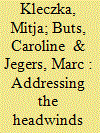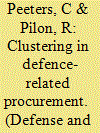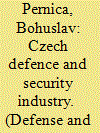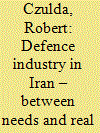|
|
|
Sort Order |
|
|
|
Items / Page
|
|
|
|
|
|
|
| Srl | Item |
| 1 |
ID:
171645


|
|
|
|
|
| Summary/Abstract |
The European arms industry is challenged by several adverse “headwinds.” Fragmentation leads to costly duplications and, in conjunction with stagnating budgets and sharply increasing costs, prevents firms from exploiting economies of scale and learning. This is exacerbated by size differentials vis-a-vis the leading US arms manufacturers and competition from emerging producers. As some “headwinds” are self-enforcing, far-reaching industrial and policy responses are required to improve the industry's outlook. As exports may not indefinitely compensate for low domestic demand, there is an economic imperative for further cross-border collaboration and consolidation. Despite various EU policy initiatives, progresses regarding the European Defence Equipment Market and strengthening the European Defence Technological Industrial Base have been relatively slow. It remains to be seen whether the European Defence Fund will be the proclaimed “game-changer,” raising competitiveness of the European arms industry. At the same time, the UK's withdrawal from the EU adds uncertainties.
|
|
|
|
|
|
|
|
|
|
|
|
|
|
|
|
| 2 |
ID:
171649


|
|
|
|
|
| Summary/Abstract |
This paper examines the importance of closer co-operation in defence-related procurement. Led by the decision that Belgium will lead the procurement of 12 Mine CounterMeasures Vessels (MCMV), the case of a potential Belgian naval construction cluster is discussed. The feasibility of a potential cluster is investigated by looking at key elements of a successful naval construction cluster, the Dutch naval construction cluster, and comparing those key elements to the current Belgian situation. Forming a sustainable Belgian naval construction cluster will be difficult. Most of the procurement process of the MCMVs is set on a European tender. In the long run, due to the absence of both a launching customer and leader firms, no party is able to carry the cluster with investments and knowledge spill-overs. In order to keep public support for large defence-related investments, clustering around the MCMV integration system and proactive cluster support is recommended.
|
|
|
|
|
|
|
|
|
|
|
|
|
|
|
|
| 3 |
ID:
171650


|
|
|
|
|
| Summary/Abstract |
The paper summarises the evolution of the iron triangle of the mutual relationships amongst the ministry of defence, defence industry, and the political elite in the post-communist Czech Republic in 1990-2020. The essay stresses the oddness of this relationship. On the one hand, the government is bound by a partnership to the Defence and Security Industry Association of the Czech Republic (DSIA), a lobbying group of more than 100 organisations that conduct business in defence and security sector in Czechia. Yet, since its creation in 2000, this assemblage of industries within DSIA's market position is falling, in fact. Neither political parties in power, nor the governments have been able to support national defence industry through the small military. Just a few DSIA national members are able to compete internationally with their cutting-edge products. Others have evolved into middlemen trading intime-expired Czechoslovak equipment retired from the Czech Armed Forces.
|
|
|
|
|
|
|
|
|
|
|
|
|
|
|
|
| 4 |
ID:
171648


|
|
|
|
|
| Summary/Abstract |
The paper’s goal is to analyses the potential of the Iranian defence industry, including both research-and-development and production capabilities. It is argued that, despite official statements about the great power and sophistication of the Iranian defence industry, in reality its capabilities are very limited and cannot meet the operational needs of the Iranian armed forces. At the same time, it is argued that many official releases, which are abundantly available in the Iranian press and often unthinkingly repeated by the Western media, do not present the real and value of military products, but are rather a tool for deception and propaganda.
|
|
|
|
|
|
|
|
|
|
|
|
|
|
|
|
| 5 |
ID:
171646


|
|
|
|
|
| Summary/Abstract |
This article analyses findings from an original survey of 187 private military contractors on their incentives for working in the industry. Perceptions of contractors as “greedy, ruthless, and unscrupulous mercenaries” shape both public and military opinions of outsourcing and may impact U.S. military effectiveness, civil–military relations, and contractor identity. We find that contractors are motivated by a range of factors and that their financial experiences are not clearly more positive than that of state military troops. We recommend broad education of military and defense officials and the public in the U.S. and other relevant nations, regarding the true incentives of modern-day, Western contractors, in an effort to dispel misperceptions, increase effective utilisation of contractors, and beneficially shape PMC-military coordination. DoD may consider integrating such training into its current efforts to improve outsourcing, including its Joint OCS Planning and Execution Course, pre-deployment fora, and curricula of advanced military studies schools.
|
|
|
|
|
|
|
|
|
|
|
|
|
|
|
|
| 6 |
ID:
171647


|
|
|
|
|
| Summary/Abstract |
The United States’ global strategic outlook has shifted markedly since the end of major combat operations in Iraq and Afghanistan. As the United States’ strategic posture shifts, the nature of military operations is simultaneously changing rapidly. Many analysts predict that cyber-operations, autonomous weapons systems, artificial intelligence, and clandestine special forces operations will be central features in future conflicts. Although often overlooked by scholars and policy analysts, defence contractors are integral to the development and implementation of these emerging categories of warfare. This inquiry examines the evolving nature of the American defence industry and the roles corporations play in current theatres of conflict. Surprisingly, rather than becoming less reliant on defence contractors after their much-maligned performance in the wars in Iraq and Afghanistan, American military and intelligence agencies have become more dependent on the private sector as technology becomes increasingly central to warfare.
|
|
|
|
|
|
|
|
|
|
|
|
|
|
|
|
|
|
|
|
|